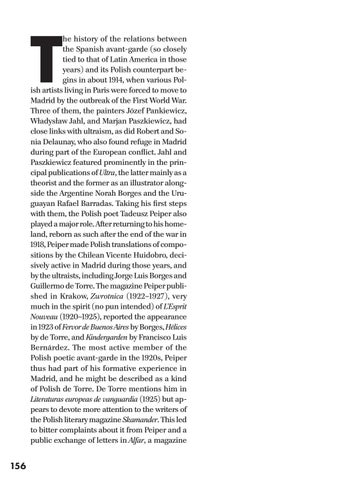T
he history of the relations between the Spanish avant-garde (so closely tied to that of Latin America in those years) and its Polish counterpart begins in about 1914, when various Polish artists living in Paris were forced to move to Madrid by the outbreak of the First World War. Three of them, the painters Józef Pankiewicz, Władysław Jahl, and Marjan Paszkiewicz, had close links with ultraism, as did Robert and Sonia Delaunay, who also found refuge in Madrid during part of the European conflict. Jahl and Paszkiewicz featured prominently in the principal publications of Ultra, the latter mainly as a theorist and the former as an illustrator alongside the Argentine Norah Borges and the Uruguayan Rafael Barradas. Taking his first steps with them, the Polish poet Tadeusz Peiper also played a major role. After returning to his homeland, reborn as such after the end of the war in 1918, Peiper made Polish translations of compositions by the Chilean Vicente Huidobro, decisively active in Madrid during those years, and by the ultraists, including Jorge Luis Borges and Guillermo de Torre. The magazine Peiper published in Krakow, Zwrotnica (1922–1927), very much in the spirit (no pun intended) of L’Esprit Nouveau (1920–1925), reported the appearance in 1923 of Fervor de Buenos Aires by Borges, Hélices by de Torre, and Kindergarden by Francisco Luis Bernárdez. The most active member of the Polish poetic avant-garde in the 1920s, Peiper thus had part of his formative experience in Madrid, and he might be described as a kind of Polish de Torre. De Torre mentions him in Literaturas europeas de vanguardia (1925) but appears to devote more attention to the writers of the Polish literary magazine Skamander. This led to bitter complaints about it from Peiper and a public exchange of letters in Alfar, a magazine
156
